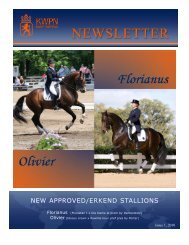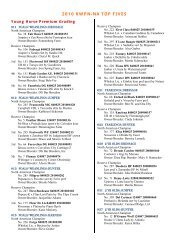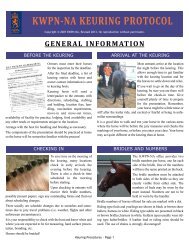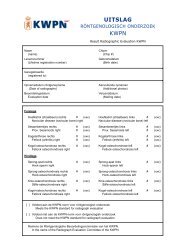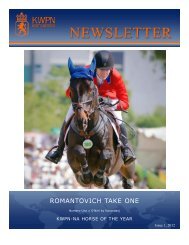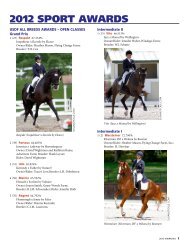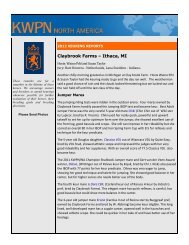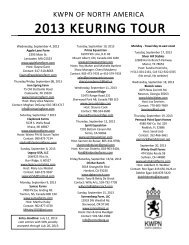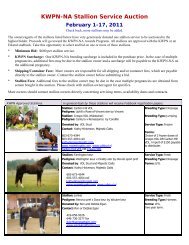Download PDF - KWPN
Download PDF - KWPN
Download PDF - KWPN
You also want an ePaper? Increase the reach of your titles
YUMPU automatically turns print PDFs into web optimized ePapers that Google loves.
Valuable information<br />
Apart from the breeding values for<br />
sport-traits, all breeding values on<br />
conformation can also be found in the<br />
“<strong>KWPN</strong> Stallion Statistics”. These<br />
breeding values depict a very detailed<br />
image on how a stallion breeds: does<br />
he produce small or large horses, does<br />
he produce a long or short neck, does<br />
he produce a horizontal or more<br />
upright neck position, etc., etc. Very<br />
valuable information if one is looking<br />
for a stallion to fits one’s mare.<br />
In summary; breeding values estimate<br />
the genetic ability of horses, they<br />
are based on information that is relevant<br />
with respect to the breeding goal<br />
and that is gathered in a systematic<br />
way. They are published and refreshed<br />
yearly and in this way are made into an<br />
important breeding tool that is available<br />
to all of us.<br />
(Note: for a more complete listing of<br />
breeding values for sport see page 26-28.)<br />
PREPARING YOUR HORSE<br />
Continued from Page 5.<br />
Under saddle classes<br />
When, according to the previous,<br />
your horse is obedient and lunging well<br />
you can also introduce the saddle and<br />
get him used to that. If you can do this<br />
yourself at home, you will save a lot of<br />
money because now you can have your<br />
horse started. If you begin early<br />
enough, the horse will be used to all the<br />
equipment and you could possible<br />
enter him in the DG Bar cup for threeyear<br />
olds, having done all the basics at<br />
home with two or three months of riding.<br />
This means you can show your<br />
horse and have him judged and compared<br />
to horses of the same age group,<br />
nationwide, by the same judges. This is<br />
a great opportunity to get a real picture<br />
of where your horse ranks amongst<br />
others of the same age. It can also be a<br />
great advertising tool, so people know<br />
what to expect before even seeing a<br />
video. If you are interested in doing<br />
Highest ranked stallions with breeding values based on pedigree, own<br />
performance and less then 25 children in sport: the “middle group” of<br />
“promising young stallions”.<br />
Breeding value Reliability<br />
Dressage<br />
Rubiquil (Rubinstein) 190 59%<br />
Ro-lex (Montecristo) 180 50%<br />
OO Seven (Rubinstein) 175 69%<br />
Paddox (Ferro) 163 61%<br />
Idocus (Equador) 160 46%<br />
Rousseau (Ferro) 159 53%<br />
Show-jumping<br />
Tangelo vd Zuuthoeve (Narcos II) 178 72%<br />
Cantos (Contender) 177 72%<br />
Phin Phin (Chin Chin) 173 73%<br />
Lupicor (Lux) 164 57%<br />
Odermus R (Calido) 161 81%<br />
Oklund (Holland) 157 79%<br />
this you need to have a plan made up at<br />
least five months before the keuring. At<br />
the latest you need to start four months<br />
before the keuring. If you’d like to do<br />
an under saddle class it is very important<br />
to know that the fastest way to get<br />
a horse ready is to make small steps<br />
forward and no steps backwards.<br />
New this year, and we are very<br />
excited about it, is the Iron Spring<br />
Farm Cup. These are classes for fourand<br />
five year old jumpers. This class<br />
will take more training than the dressage<br />
portion of the IBOP or the DG Bar<br />
Cup. These classes will be judged on<br />
style, technique and how the horse<br />
goes between the jumps. Willingness is<br />
very important in this class. I would<br />
advise to do some schooling shows<br />
before entering this class. The courses<br />
will be straight forward with easy distances<br />
and will be very inviting for the<br />
horse.<br />
The ISF Cup will be a little more<br />
difficult than the jumping for the IBOP.<br />
In the IBOP you can show the horse the<br />
jumps ahead of time, you can take<br />
practice jumps in the ring, you can go<br />
back to the trot when you change directions<br />
and the height of the jumps is<br />
adjusted if necessary. When jumping in<br />
the ISF Cup the horse warms up in a<br />
warm-up arena, the distances and<br />
heights of the jumps are set and<br />
because the horse is judged in the manner<br />
of going between the jumps he<br />
should not break into the trot. Another<br />
difference between the two is that in<br />
the IBOP the horse also free jumps<br />
after jumping under saddle and this<br />
may help the evaluation.<br />
If you have any questions about the<br />
keuring or any of the classes feel free<br />
to contact your keuring host or the<br />
office and I wish everybody a safe and<br />
good keuring season.<br />
Page 11 • Newsletter



